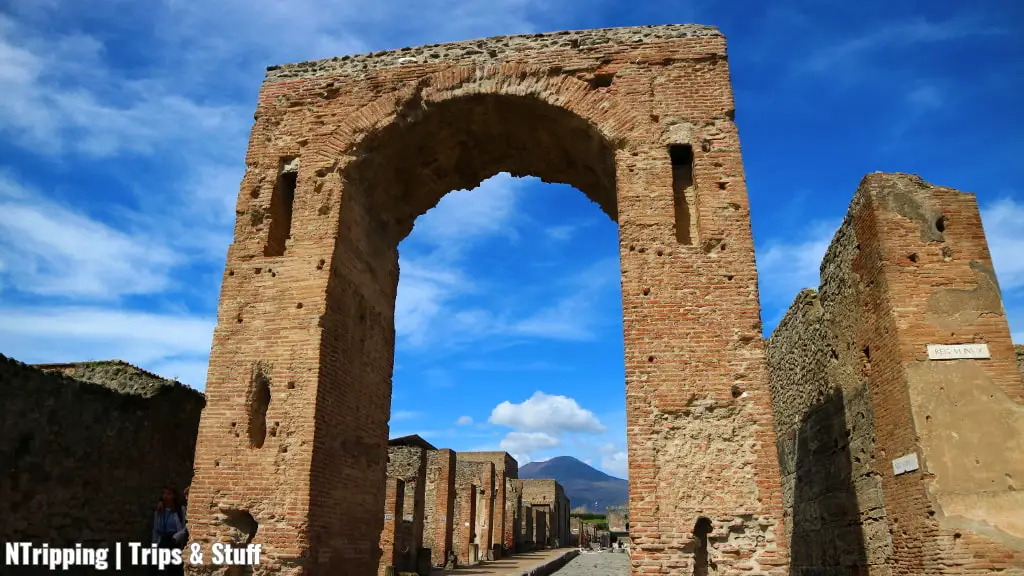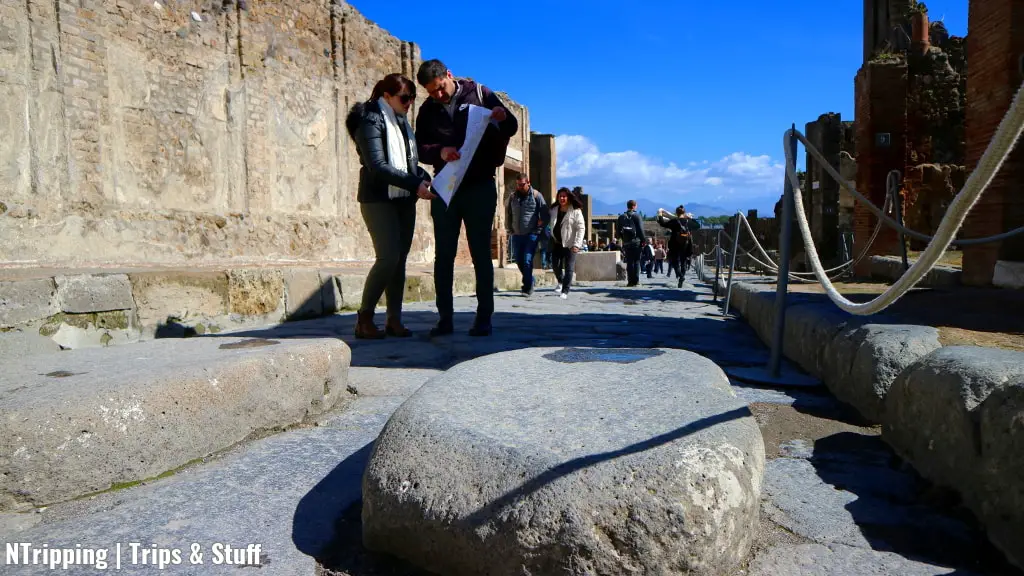How to Visit Pompeii Like a Real Adventurer

Visiting Pompeii must be on every real explorer’s adventure list!
How to know if it’s for you? Answer this:
- Have you ever wondered how people lived twenty centuries ago?
- Have you wished you could walk the same streets where Roman Empire soldiers marched at the beginning of the first millennium?
- Is getting lost wandering the backyards of ancient cities on your bucket list?
If yes, then be ready to satisfy your adventurer’s thirst!
Every living creature in the city of Pompeii near the shores of the Tyrrhenian Sea in Italy was wiped out of the face of the Earth by the horrific eruption of the nearby Mount Vesuvius. However, what was a real tragedy for the city is nowadays the best snapshot of life in the 1st century AD.

You can explore an almost unchanged ancient city and feel like a real adventurer going back 2,000 years! That’s it, of course, if you know how to best visit Pompeii ;)
Prepare to dig in the most important tips that’ll make you feel like wearing the rugged boots of Indiana Jones.
Learn the History of the Horrifying Eruption That Wiped the Prosperous City

In the 1st Century, just before the catastrophic eruption of Vesuvius wiped the entire city overnight, Pompeii was a prosperous settlement near the shores of the Tyrrhenian Sea.
The city existed for about seven centuries and reached a population of 20,000. Then one night the volcano erupted.
On August 24th, 79 AD, lava washed the streets of Pompeii, leaving burn marks on stone pillars and bricked houses. The people of Pompeii were in their beds and the lava crystallized their sleeping bodies.
After the lava settled, ashes from the volcano rained on the city for three days. The roofs of the buildings collapsed and Pompeii was buried under a thick layer of destruction.
It took explorers over 1,600 years to start uncovering the forgotten city under the ashes.
The archaeological site has been a tourist attraction for over 250 years now and a UNESCO World Heritage Site since 1997. It receives 2.5 million visitors per year.
Most of the city is restored and you can walk along the wide streets, look into the backyards, and step inside the thermal baths and the palaces. You can climb the stairs of the amphitheater or get lost in the narrow back alleys for hours.
The lava has left marks on the stones. It melted parts of the pillars but they still stand strong and tell the horror stories of the night when Pompeii ceased to exist.
At the same time, Vesuvius wiped out the neighboring cities of Herculaneum and Torre Annunziata as well. If your time allows it, you should add all three archaeological sites – Pompeii, Herculaneum, and Torre Annunziata – to your itinerary.

Plaster casts of the bodies in sleeping positions are displayed in several locations, revealing the sudden dreadfulness. People went to bed unaware of what was going to happen that tragic night in 79 AD.
Discover the Location Near the Shores of the Tyrrhenian Sea With the Imposing Vesuvius
Pompeii is located between the busy Naples (25 km / 15.5 mi away) and the picturesque Amalfi Coast (35 km / 22 mi away) near the shores of the Tyrrhenian Sea. Moreover, the Italian capital is a mere 240 km / 150 mi away. Meaning, you can easily visit Pompeii from Rome as well.
Mount Vesuvius, the active volcano that extinguished all life from Pompeii, is still towering over the city, like a giant monster enjoying the look of the remains of its victims.
The last volcano eruption happened in March 1944. Since then, thankfully, Vesuvius only erupts gas with an unpleasant smell but poses no danger to the people in its proximity.
However, at any moment the volcano could repeat the horrifying events of 79 AD. Therefore, if you visit Mount Vesuvius in search of answers to the events of the disastrous night 20 centuries ago and hear thunder or feel odd vibrations below your feet, forget everything and everyone and run head over heels downhill.

If it’s indeed another eruption, this probably won’t save you but you have got to at least try to escape the deadly lava, right?
Study the Itineraries and Decide How Much of the Ruins of Pompeii You Can Visit
The rich ancient harbor city with an estimated population of 20,000 people occupies a rather large territory. Do not underestimate the grandeur and size of Pompeii!
The archaeological site spreads over 66 hectares, most of which are already excavated.
The sudden death of Pompeii left behind a snapshot of life as it was 2,000 years ago.
According to the official guide to the ruins of Pompeii, the shortest itinerary takes approximately 2 hours. To visit everything on the longest suggested itinerary, you’ll need a whole day!
Remember that the cobblestoned streets are rather uneven and thus difficult to walk even for a fit person. Add to the tiring exercise all the information you’ll absorb and the thoughts and emotions, chasing through your mind, and you’ll have an idea of how exhausting visiting Pompeii is.

I certainly don’t want to discourage you from visiting Pompeii with the above warnings. I simply want to prepare you better than I was prepared when I visited the huge excavation site. So after you pay for your ticket and grab a map of the city, spend five minutes of your precious time studying the map and choosing the perfect itinerary for you.
Two main streets traverse the city of Pompeii.
Via dell’Abbodanza (Abundance Road) will take you all the way from the entrance at the Marine Gate to the Amphitheatre. The wide street is over one kilometer long and passes by the Odeon, shops, temples, the Stabian Baths, and commercial facilities.
From North to South, Via Stabiana cuts the city in two and connects the Vesuvius Gate with the Theatre District.

Whatever itinerary or route you choose for your tour of Pompeii, don’t forget to explore the narrower back alleys and the intimate corners of the stunning Roman city.
Check the Transportation Options Before You Visit Pompeii Archaeological Site
It isn’t difficult to travel from Naples to Pompeii or even from Rome to Pompeii. In facts, visiting Pompeii is one of the best day trips from Naples you can take.
- By train: from Naples to Pompeii, it takes approximately 40 min. If you’re coming from Rome to Pompeii, you will need a little over an hour to reach Naples and then will have to change trains to reach your final destination. Check the timetable and prices at Trenitalia’s website.
- By bus: buses from Naples will take you to Pompeii in approximately half an hour. The bus ride from Rome takes 3 h.
- Join a tour: this option is easiest, as you don’t have to worry about much. The only problem is the lack of flexibility and that’s exactly what a real adventurer like yourself needs the most, isn’t it? Before you make up your mind, check these tours of Pompeii from Naples and pick the best option for you!
Your main concern when choosing should be, in my opinion, to optimize your time. The more time you have to explore the fascinating streets of Pompeii, the deeper and more memorable your exploration will be.

You can easily spend hours just sitting at a street corner and observing other tourists passing by while imagining what city life in the 1st century AD would have been like. Or finding a quiet spot in one of the mansions’ backyards and exploring clues of the path the lava took through the building.
Know the Opening Hours and the Ticket Prices of Going Back in Time
In 2018, the Pompeii tickets are at the reasonable price of 13 € / $16 (adults) or 10 € / $12 (reduced).
However, on some holidays the entrance for certain groups of people might be free. On March 8th, International Women’s Day, our party of three paid the price of only one Pompeii ticket. Yes, that’s right, the two women in the group visited for free!
The Pompeii archaeological site opening hours are:
- Between April and October: 9:00 AM – 7:30 PM (weekdays), 8:30 AM – 7:30 PM (weekends). The last admission to the excavation site is at 6:00 PM.
- Between November and March: 9:00 AM – 5:00 PM (weekdays), 8:30 AM – 5:00 PM (weekends). The last admission to the excavation site is at 3:30 PM.

While I cannot tell you how much time to spend exploring, people watching, or relaxing, I can encourage you to devote as much as possible of your time inside the walls of Pompeii.
As you can imagine, Italian summer is extremely hot. Touring Pompeii’s cobblestoned streets in the heat is not advisable. If possible, choose the months between October and March for your visit. Pray for a day without rain as the wet stones become slippery.
In any case, bring enough water and snacks. There are a few cafés inside the city walls and facilities at several locations but better come prepared and not waste precious time on a quest for food and drinks.
If you wish to visit Mount Vesuvius on the same day, a bus ride from the gates of Pompeii will cost you 3.10 € ($3.80) and the entrance fee to the volcano will set you back another 10 € ($12). You’ll need to climb the final steep 800 m (0.5 mi) to reach the crater, so wear solid shoes and bring enough water with you.

About 2 hours should be enough time to visit Vesuvius and enjoy the panorama (on a nice day). Pay attention to the Vesuvius opening hours:
- In January, February, November, and December: 9:00 AM – 3:00 PM.
- In March and October: 9:00 AM – 4:00 PM.
- In April, May, June, and September: 9:00 AM – 5:00 PM.
- In July and August: 9:00 AM – 6:00 PM.
My advice is to try to visit Pompeii and Vesuvius on separate days. If your time allows it, add a visit to the smaller cities, ruined by the volcano – Herculaneum, Oplontis, Boscoreale, and Stabiae.
Now You Know How to Step into the Past and Feel Like a Real Adventurer in Pompeii

Do you feel the adrenaline rushing through your veins already?
Are you searching for cheap flights to Italy in the next browser tab?
Don’t deny it. If you’ve read the above lines, I am sure you’re convinced you simply have to add a visit to the ruins of Pompeii to your bucket list. It is without a doubt one of the best things to do in Italy.
The catastrophic disappearance of Pompeii from the map of the world and the miraculous rediscovery 16 centuries later is one of the greatest archaeological wonders. We are all fortunate to be able to wander the streets of Pompeii where 2,000 years ago life had been extinguished in a matter of hours.
Are you ready to be a time-traveler on a tour to Pompeii, step into the past, and feel like a real adventurer?
I found the last hours before closing to be the best time for visiting Pompei: it is not so full then :)
Nice tip! Thanks for sharing, Guini :) My only concern is if time would be sufficient to see the huge archaeological park.
Very good informative post, hope to visit the site one day.
Thank you! Pompeii is a real gem for history buffs, you should definitely visit it :)